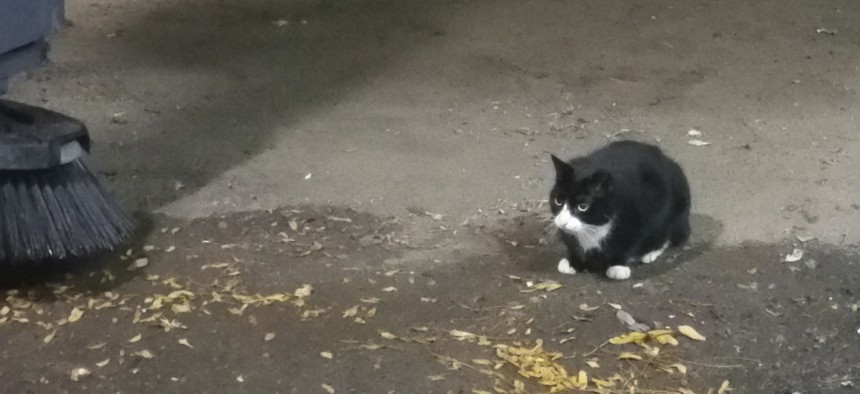Cats Are No Match for New York City’s Rats

Sylvester, a feral cat, sits in a loading dock at the Jacob Javits Convention Center, Thursday, Oct. 20, 2016 in New York. AP Photo
Despite popular wisdom, rats are too big and too fierce for cats.
In 2017, Michael H. Parsons finally secured a site to study rats in New York City. You would think that’s easy in Pizza Rat’s native land, but Parsons, a visiting researcher at Fordham University, says the process took “blood, sweat, and tears”: Since rats in New York invariably live on somebody’s property, that somebody has to let rats roam free for scientists to observe. Most people—if they’re going to let the scientists in—want the rats dead.
So it was a big deal when Parsons managed to convince a Brooklyn recycling plant to host his team’s research on rat pheromones, which are invisible chemicals that affect rodent behavior. Parsons and his team set up motion-triggered cameras around the plant. They carefully microchipped the site’s rats under anesthesia. And they set out pheromones to start collecting data.
Then, the cats came.
For scientists who try to control every possible variable in their experiments, the cats could have been a disaster. There were five to seven felines, all feral. Parsons thinks they were drawn to the pheromones the research team was using in the recycling plant. He didn’t want to scrap the research project, so he and his team decided to roll with it: They would now study how cats affect rat populations.
The answer seems like it would be obvious. For as long as humans have lived with cats, we have been using them to keep rodents in check. In several cities in the United States, municipal rodent-control and cat-rescue groups have put homeless cats to “work” by releasing them in rat-heavy neighborhoods. In Chicago, the program was so popular that there was a six-month waiting list to get a cat.
But the results from the Brooklyn recycling plant are far less flattering to cats: They are absolutely lousy rat-killers. Over a period of five months, the motion-triggered cameras captured just two successful kills. And this was in a place crawling with rats; the population was estimated at around 150. The cameras captured 20 other stalking attempts and one other failed attempt to kill a rat.
These results actually match what rat experts have been saying all along: Cats are not a good way of controlling city rats. The felines are excellent at catching mice, but adult rats grow 10 times as big as mice. And rats are fierce. “Once rats get above a certain size, rats ignore cats and cats ignore them,” says Gregory Glass, a professor at the University of Florida who has studied cat and rat interactions in Baltimore. “They’re not the super predator that folks have thought them to be.” But the misconception persists.
Feral cats also bring their own problems when they’re introduced to an area. They spread diseases like toxoplasmosis. They also kill smaller wildlife. “Cats are opportunistic predators,” says Christopher Lepczyk, a wildlife biologist at Auburn University who studies feral cats. They’ve been observed to eat everything from crayfish to turtles to bats. Most controversially, they kill birds. Most birders hate feral cats.
All of these animals are usually easier to kill than a big, tough adult rat. Even easier for cats is looking cute to sucker a human into feeding you. Or just eating trash—of which there is plenty in a city. Jamie Childs, a researcher at Yale who has also studied cats and rats in Baltimore, says that only very desperate and very hungry cats are likely going to go for an adult rat. Most of the time, there’s plenty of other food. “I see cats and rats eating out of the same trash piles,” he told me on the phone.
“At the same time?” I asked.
“At the same time.”
Sarah Zhang is a staff writer at The Atlantic, which originally published this article.
NEXT STORY: The Always-On Police Camera





